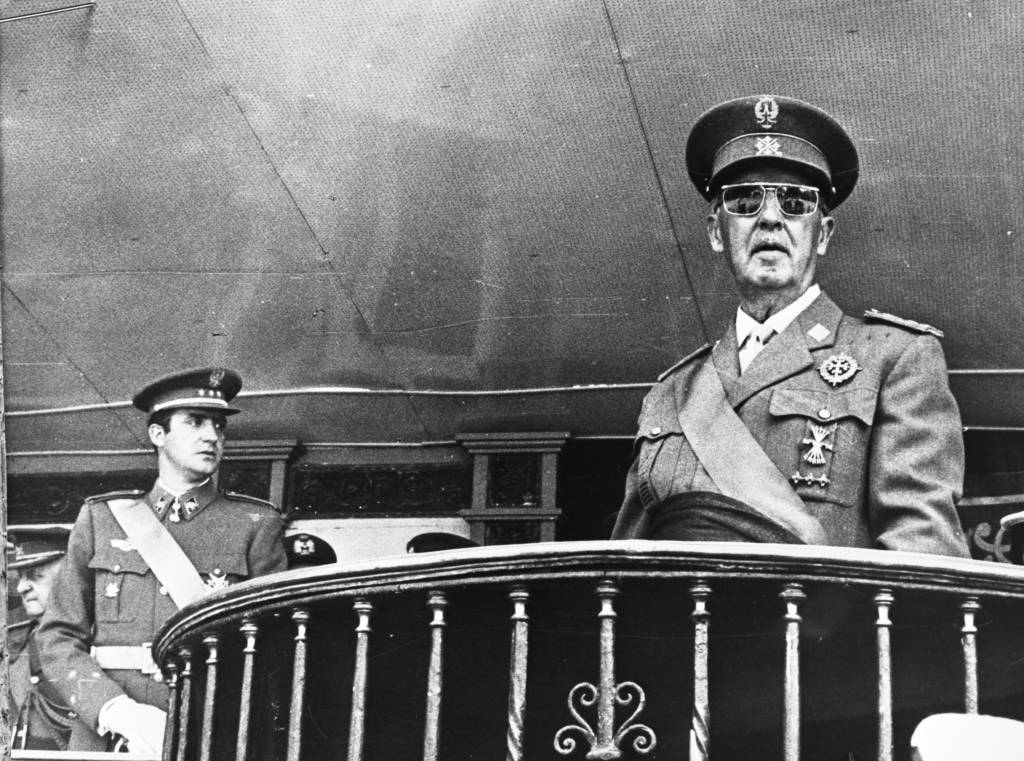Spain Struggles to Leave Fascist Past Behind

Is Spain’s exhumation of Francisco Franco’s body a sign the country is confronting its fascist history or merely a political move intended to win votes and election seats?
After more than 40 years of democracy, Spain is still struggling to leave the legacy of its fascist past behind despite the government’s recent exhumation of former dictator Francisco Franco’s body to a less ostentatious site.
Franco had been buried in the Valle de los Caídos, the gigantic shrine to fascist values he constructed using political prisoners as forced labor. However, the country recently took a huge step toward addressing holdovers from his dictatorship on October 24 by finally exhuming the former dictator’s body from his grave in the Valle de los Caídos – a monument and religious site that boasts the tallest cross in the world and whose basilica is even bigger than St. Peter’s Basilica in Rome.
Removing Franco’s body was no easy task, and acting Prime Minister Pedro Sánchez of the center-left party, the Partido Socialista Obrera de España (Spanish Socialist Worker’s Party), commonly known as PSOE, had to fight tooth and nail to finally fulfill his pledge to move the body to a site deemed more appropriate and with less reverence for the dictator.
Many people in Spain have fond memories of the days of the dictatorship, and right-wing extremists and Franco supporters commonly made pilgrimages to Valle de los Caídos to pay homage to the fallen dictator. 1975, the last year of Franco’s rule and life, is a time still fresh in many peoples’ memories. Some Spanish citizens associate Franco’s dictatorship with social stability and long for a return to the days when political dissidents disappeared and had their voices silenced immediately. Still, others remember Franco’s economic contributions to the Spanish state, such as the codification of social security and pensions for retirees.
Is Spain Ready to Confront Fascism?
Not all Spaniards are convinced Sánchez’s motives were based on a true desire for Spain to confront its fascist history. Instead, some believe the push to move Franco’s body was simply a move to gain political currency and curry favor with liberal voters while pushing conservatives farther to the right, weakening their political base.
Gustavo Ramírez, Ph.D., a history professor in Spain, told Citizen Truth, “I’m not sure the government is interested in closing the book on Franco’s legacy because they are getting political benefits from the conflict. As long as they can blame Franco, it’s good for the politicians in power.”
Critics of the Spanish government argue there is a tendency toward engaging in symbolic actions such as exhuming Franco’s body in lieu of actually remedying the many problems still haunting Spain after decades of fascist, authoritarian rule. One such concern is identifying the hundreds of thousands of bodies lying in mass graves around the country. According to the Spanish Ministry of Justice, there are still approximately 1,200 mass graves in Spain that have yet to be excavated.
Ramírez explained that this was not the first time that politicians have used issues related to Spain’s Francoist past in order to curry political favor. According to him, during the government of José Luis Rodríguez Zapatero, another PSOE politician who served as prime minister from 2004 to 2011, the mass graves littering the Spanish countryside became a huge political issue as part of an effort to re-energize support for the Socialist Party.
“It was not until President Zapatero came to power that the wound was reopened. And again, I think it was a matter of political strategy. In many senses the Socialist party and Popular party [center right Spanish political party] programs were so close to each other that the only way they could give energy to the Socialist party was by drawing attention to this issue,” Ramírez told Citizen Truth.
Additionally, the exhumation of Franco occurred just prior to Spain’s November general elections, casting more suspicion that Sánchez attempted to time Franco’s exhumation just right so that his party could win as many seats as possible during the election.
“If you look at the reaction among certain people, some people think Sanchez just wanted the votes of the far-left or wanted to drive far-right voters to Vox [the ultra-right Spanish political party]. I think it was a matter of political strategy rather than justice. If he really wanted to move the body, it could have been done 30 years ago when the socialist party was in power,” Ramírez told Citizen Truth.
The Fall of Franco
Francisco Franco, of course, would eventually die but did his death bring the end of Franco’s fascism? As Franco’s health worsened during the second half of the 1970s, he began the process of transforming his fascist government into one of absolute monarchy to appease traditional conservatives and silence angry leftist voices.
The heir apparent to the Spanish throne was Juan de Borbón, who held the title of Conde de Barcelona, or “Count of Barcelona” and was the oldest son of Alfonso XIII, the last king of Spain before the institution of a democratic republic in the early 20th century.

Francisco Franco with Juan Carlos de Borbón to his left in 1969. (Photo: Anefo)
Franco thought de Borbón was too liberal and would fail to continue the ultra-right political trajectory that Spain was following, so he chose de Borbón’s son, Juan Carlos I to be the next leader of Spain.
Sara Isabel García López, a Spanish high school administrator, told Citizen Truth, “There are people who think the transition to democracy in Spain was a betrayal, and the deal Franco made with the then-Prince of Spain Juan Carlos was based on the agreement that the ideas of Franco’s fascist regime would continue as the government transitioned into its next phase.”
For most of his personal and political life, Juan Carlos appeared to be a firm backer of Franco and his regime, but as the dictator’s health worsened, Juan Carlos began to meet with activists and politicians from democratic groups to figure out the best way to transform Spain into a modern democracy.
Juan Carlos was largely responsible for the transition toward a modern government, using his position as the most important and powerful politician in Spain to reduce the power of the monarchy and transform Spain into a parliamentary democracy. He also played a major role in stopping the would-be coup of Feb. 23, 1981, when Franco sympathizers in the Spanish military attempted to take control of the government. It was also King Juan Carlos’ decision to bury Franco in the Valle de los Caídos; Franco himself never stated he wished to be buried there.
Consequences of Franco’s Fascism
Despite Juan Carlos’ apparent move away from fascism, Franco’s nearly 40-year rule was and still is deeply etched into Spanish culture and its traces are not easily removed.
According to Ramírez, “Franco’s version of authoritarian dictatorship was very different from other forms of fascism that existed at that time. Most fascists were not Catholic at all; Mussolini, for example, was openly atheist. When the fascists from Italy and Germany came during the civil war to help Franco’s side, they were amazed. They wondered ‘What type of supposed or pretend fascists are these, as they are going to church and mass every day.’”
Franco’s dictatorship, Ramírez explained, was based on his personal ideas regarding traditional Castilian Spanish culture, the influence of the Catholic church, and Spanish homogeneity rather than a traditional fascist doctrine.
“The party was absolutely controlled by Franco. He actually believed he was sent by God to save Spain from anarchism and communism. He had a religious ideology that was very conservative and based on the ideas of the Council of Trent. Franco saved the Spanish Catholic Church from complete destruction because the Republicans were systematically trying to exterminate the Church killing Catholic priests and even Catholic activists.”
Franco’s support of the Catholic Church extended into almost all areas of daily life in Spain, but the effects were especially present with regard to the Spanish education system.
“The Catholic Church got a lot of special privileges with regard to education. For example, religion classes were compulsory. It was the golden age of private Catholic schools. Most of them still exist to this day,” Ramírez told Citizen Truth.
Just as these private Catholic institutions still exist, so do many other troubling remnants of Franco’s dictatorship. Part of Spain’s transition process after Franco involved granting diplomatic immunity to many members of Franco’s regime who engaged in heinous crimes against humanity, and many of these individuals still hold positions of political power or social influence. Many families of individuals who “disappeared” during the Spanish Civil War and the ensuing dictatorship have no idea what happened to their loved ones, and unfortunately there is a chance they never will.
Spain may have just closed one symbolic chapter of its troubled past by moving Franco’s body, but many wrongs still need a remedy before every Spanish man, woman and child can find peace and closure. However, given the volatile nature of the current political situation in Spain, it’s likely these issues will continue to be used for political gain instead of being addressed in a manner that will benefit those who suffered during the years of Franco’s rule.















